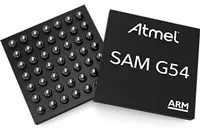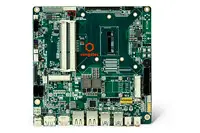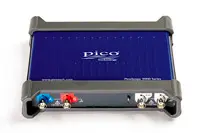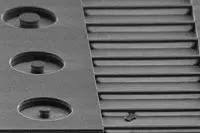Electronics News
Archive : 5 January 2015 год
 Atmel has expanded its SAM G series of ARM Cortex-M4 based MCUs with the addition of the SAM G54 and SAM G55 devices, targeted at Internet of Things (IoT) applications requiring higher performance, lower power consumption and smaller form factors.
Atmel has expanded its SAM G series of ARM Cortex-M4 based MCUs with the addition of the SAM G54 and SAM G55 devices, targeted at Internet of Things (IoT) applications requiring higher performance, lower power consumption and smaller form factors.
"Designers are looking for simple to use solutions with an edge to help bring their differentiated products faster to market for both wearables and sensor hub management," claimed Vince Murdica, senior director of Sensor Centric Systems.
Available in WLCSPs as small as 2.84 x 2.84mm, as well as in 64pin QFP and QFN, the parts run at clock rates up to 120MHz. Power consumption is said to be as low as 102µA/MHz in active mode. Each part has up to 512kbyte of flash and up to 160kbyte of SRAM.
Additionally, the G55 series enables designers to specify the amount of SRAM required in sleep mode to further improve power efficiency.
Author
Graham Pitcher
Source: www.newelectronics.co.uk
 Embedded computing specialist congatec has added 5th generation Intel Core processor based platforms to its portfolio. The company says the processors – being manufactured on a 14nm process – bring better graphics and performance, with power consumption as low as 15W.
Embedded computing specialist congatec has added 5th generation Intel Core processor based platforms to its portfolio. The company says the processors – being manufactured on a 14nm process – bring better graphics and performance, with power consumption as low as 15W.
The conga-TC97 is a COM Express compact Type 6 module with eight USB ports, two of which support USB 3.0. There are also four PCI Express 2.0 lanes, four SATA ports running at up to 6Gbit/s, RAID support and a Gigabit Ethernet interface.
The conga-IC97 is a Thin Mini-ITX board with four USB 3.0 ports available on the I/O shield. Two 5Gbit/s PCI Express 2.0 lanes can be used as mPCIe Half Size and PCIe Full Size shared with PCIe x1 and mSATA, whilst fast and flexible system extensions are possible using four SATA interfaces.
Both boards support up to three independent display interfaces via HDMI 1.4, LVDS and embedded DisplayPort. Intel's HD Graphics 5500 and 6000 chipsets are said to deliver 'stunning and responsive' visuals, including Ultra HD 4K display and additional codec support.
Author
Graham Pitcher
Source: www.newelectronics.co.uk
 The Semiconductor Industry Association (SIA) says worldwide sales of semiconductors reached $29.7billion in November 2014, an increase of 9.1% over the same month in 2013. Meanwhile, year to date sales in 2014 were said to be 10% higher than at the same point in 2013.
The Semiconductor Industry Association (SIA) says worldwide sales of semiconductors reached $29.7billion in November 2014, an increase of 9.1% over the same month in 2013. Meanwhile, year to date sales in 2014 were said to be 10% higher than at the same point in 2013.
"Global semiconductor sales through November have matched the total from all of 2013, assuring that the industry will achieve a new record for sales in 2014," said SIA president and CEO Brian Toohey. "Demand remains strong across nearly all semiconductor product categories and the Americas and Asia Pacific regional markets continue to post the most robust growth. Macroeconomic trends bode well for continued growth into 2015."
Regionally, year to year sales increased in the Asia Pacific (12.3%), the Americas (11.1%), and Europe (3.4%), but decreased by 4.5% in Japan.
Author
Graham Pitcher
Source: www.newelectronics.co.uk
 A range of oscilloscopes from Pico Technology is said to be suited to use by mainstream electronics design engineers. Called the PicoScope 3000D Series, the devices offer bandwidths of up to 200 MHz bandwidth, two or four analogue channels plus 16 digital channels on the mixed signal models. With memory sizes ranging from 64 to 512Msamples, the scopes offer a maximum real time sampling rate of 1Gsample/s and feature a USB 3.0 interface and a built-in arbitrary waveform generator.
A range of oscilloscopes from Pico Technology is said to be suited to use by mainstream electronics design engineers. Called the PicoScope 3000D Series, the devices offer bandwidths of up to 200 MHz bandwidth, two or four analogue channels plus 16 digital channels on the mixed signal models. With memory sizes ranging from 64 to 512Msamples, the scopes offer a maximum real time sampling rate of 1Gsample/s and feature a USB 3.0 interface and a built-in arbitrary waveform generator.
"The deep memory on the PicoScope 3000D means that you can use long timebases with the fastest sampling rates," explained managing director Alan Tong. "Even at 1Gsample/s, you can capture a 500ms waveform –half a billion samples – while hardware acceleration keeps the display updating smoothly."
The buffer memory can be segmented, enabling acquisition of up to 10,000 individual waveform segments of 50,000 samples, with a rearm time of less than 1µs between each segment. Memory segmentation is said to be beneficial when analysing waveform bursts or serial data packets that include long gaps. PicoScope can be set to trigger on each packet and skip the gaps that are of no interest. This function allows users to acquire, for instance, CAN data packets over several minutes and then analyse the packet content later.
The new scopes benefit from the latest updates to the PicoScope software, including a new fast persistence mode that updates around 100,000 waveforms per second. Maths channels have also been expanded to include configurable filters.
Author
Graham Pitcher
Source: www.newelectronics.co.uk
 Researchers from Harvard, the University of California, Santa Barbara, and the University of Chicago have enhanced the fluorescent light emission of diamond nitrogen vacancy (NV) centres, a move said to have promise for quantum computing.
Researchers from Harvard, the University of California, Santa Barbara, and the University of Chicago have enhanced the fluorescent light emission of diamond nitrogen vacancy (NV) centres, a move said to have promise for quantum computing.
NV centres contain an unpaired electron that can store information using spin. The electron's spin state can be read by observing the intensity of particular frequencies of light emitted by the NV centre when illuminated by a laser.
To amplify the most important element of the signal researchers used a photonic cavity. "A photonic cavity that is properly matched to the NVs can substantially augment their capabilities," said Evelyn Hu, a researcher at Harvard. NV centres with signals enhanced by photonic cavities could act as qubits, the fundamental units of quantum information in a quantum computer.
The team said photonic cavities best enhance the signal of NV centres located in a 'hot spot', where the cavities' resonant fields are strongest, but making sure a defect's location matches up with this spot is tricky.
A first step was taken towards this goal by controlling the depth of the diamond defects using a technique called delta doping. "Integrating a plane of spins into these structures enables us to engineering the spin-photon interaction and exploit quantum effects for future technologies," said David Awschalom, a researcher at the University of Chicago. The technique confines the possible location of NV centres to a layer approximately 6nm thick sandwiched inside a diamond membrane approximately 200nm thick. Holes were then etched into the membrane to create the photonic cavities.
Using this method the researchers were able to increase the intensity of the light emitted by the NV centres by a factor of 30. The team believes the emission can be enhanced by controlling the position of the defects in the horizontal plane and is working on ways to achieve 3D control.
Author
Graham Pitcher
Source: www.newelectronics.co.uk

